37 Search Results for praactical teaching in the asd classroom
April 18, 2016
by Carole Zangari -
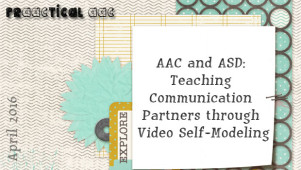
It is an honor to have Dr. Joanne Cafiero, an AAC consultant for individuals with complex communication needs and Autism Spectrum Disorders, as a guest contributor for today’s post. Dr. Cafiero is the author of Meaningful Exchanges for People with Autism an Introduction to AAC (2005). She is a consulting editor for Focus on Autism and Other Developmental Disabilities and has guest edited several of ASHA’s Perspectives in AAC. She was a member of the National Academy of Sciences Committee on Educational Interventions for Children with Autism (2001) and is currently working on an update on AAC and Autism for the Academy. In this post, she shares some of her work on video self-modeling. ::::::::::::::::::::::::::::::::::::::::::::::::: Growing research and first-person reports are illuminating the unique sensory and motor differences experienced by people on the Autism Spectrum. This new information has a huge impact on the AAC practitioner. Motor planning differences in ASD can... [Read More...]
April 10, 2016
by Carole Zangari -
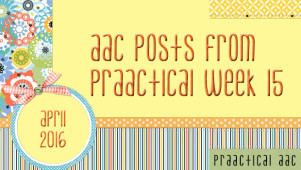
Had a busy week? Here are a few posts that you may have missed. Monday – PrAACtical Teaching in an ASD Classroom: Little Tips for Big Core Wednesday – Video of the Week: AAC at Home Thursday – Beyond Autism Awareness to Acceptance, Understanding and Inclusion
March 20, 2016
by Carole Zangari -
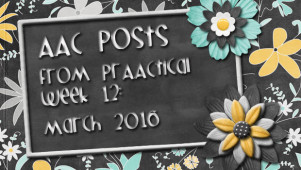
Hope your prAACtical week was productive and satisfying. Monday – PrAACtical Teaching in the ASD Classroom: Bigger is Better with Core Vocabulary Wednesday – Video of the Week: Building Linguistic Fluency with AAC Learners Thursday – AAC Assessment Corner with Vicki Clarke: Is Feature Matching Still Relevant?
November 9, 2015
by Carole Zangari -
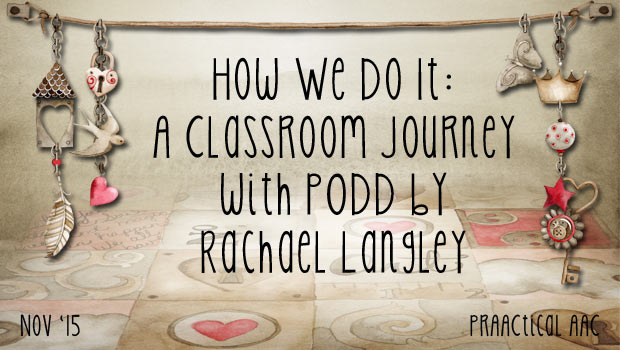
Let’s face it. Good AAC implementation takes commitment and requires a lot of effort from those who are with the AAC learners throughout the day. Sometimes an AAC tool or strategy that seemed promising at first, doesn’t pan out to be as successful as expected. Other times, it’s a challenge to keep up with the demands of the classroom, therapy session, and life and still find the energy to consistently implement good AAC practices. In the real world, teams struggle with these issues every single day. So when Rachael Langley, a Michigan-based SLP and AAC specialist, offered to provide insight into what that process has been like in classrooms she supports, I was thrilled. Rachael’s original post about using PODD in the classroom and her follow-up post on implementation tips gave us insight into the journey that one elementary school classroom team is taking to better serve their students with little or no... [Read More...]
August 10, 2013
by Robin Parker -

As we were getting ready for back to school and thinking about ‘must haves’, it quickly became apparent that it is not so easy to narrow it down. And the ‘must haves’ would definitely vary depending upon type of class, students, and even school. Based on a wide variety of differences, we organized a wide variety of choices to explore (we apologize in advance if we got carried away but…). Choose what you need, bookmark what you may need later and let us know your ‘must haves’ for a classroom and speech room AAC collaborative approach. We will create an ongoing list. Get Started Before School Starts Do these 10 Things to Get Started with AAC if you are new to an AAC student or classroom Provide AAC Support in the Classroom. Support teachers and educators with tips from Jane Farrall, & learn about AAC in the Classroom by Joan... [Read More...]
May 6, 2013
by Carole Zangari -
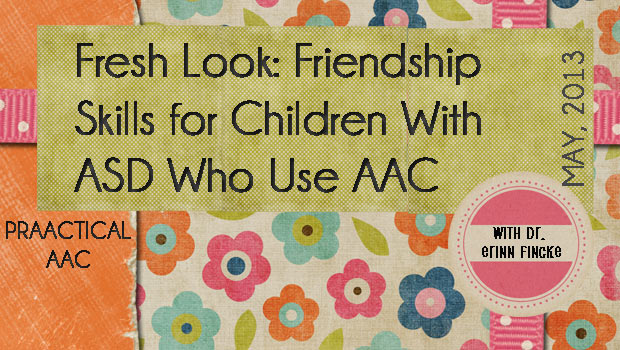
As we’ve said before on this blog, SLPs have great potential to make a difference in the social experiences of people who use AAC by supporting the development of friendships. ASHA’s Better Speech and Hearing Month (#BHSM) gives us a great opportunity to spread awareness that this is an area in which SLPs can make a tremendous difference. We’re so excited to share this Fresh Look post by Dr. Erinn Finke, Assistant Professor of Communication Sciences and Disorders at Penn State University. I was recently lucky enough to find myself in conversation with Pat Mirenda, a top researcher in the field of AAC and Autism Spectrum Disorders (ASD). In trying to decide what we really “know” about effective AAC strategies for children with ASD, we decided that while there is a lot of research regarding how to use AAC to teach children with ASD to request things, there really is not... [Read More...]
August 26, 2019
by Carole Zangari -
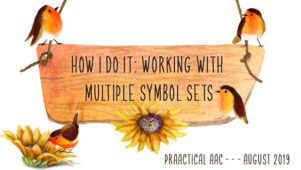
Amanda Samperi is back with the second post in her series about getting ready to return to school-based AAC services. Amanda is an AAC SLP who has worked in a variety of service delivery settings and runs the blog, AAC is Where It’s AT. Currently, she provides push-in language therapy to children with complex communication needs at a substantially-separate center school in Florida. She also conducts AAC/AT evaluations, provides year-round parent trainings, and assists the SLP team in instructing teachers/staff about communication supports and strategies In today’s post, she addresses a situation faced by many AAC teams: Serving children who use a variety of different AAC symbols and systems. If you missed Amanda’s initial post on back-to-school AAC, you can catch up on that here. ::::::::::::::::::::::::::::::::::::::::::::::::::::::::::::::::::::::::::::::::::::::::: How I Do It: Working with Multiple Symbol Sets It’s the beginning of the year – desks are in their spots, students’ names are... [Read More...]
June 14, 2021
by Carole Zangari -
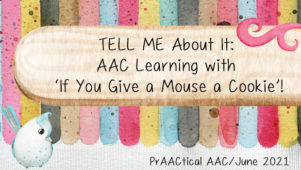
Ready for another post with book-related ideas for supporting core vocabulary learning in preschool classrooms? Today, we end another wonderful year of Jeanna Antrim and Maggie Judson’s TELL ME About It series with a terrific post featuring the book If You Give a Mouse a Cookie. If you’re in search of ways to support preschool teachers who are implementing the TELL ME program with their young students, this post will give you lots of tried-and-true ideas. Maggie and Jeanna are speech-language pathologists who work in the Assistive Technology Department for the Belleville Area Special Services Cooperative (BASSC) in southern Illinois. They are AT/AAC facilitators and provide evaluations, direct therapy, consultations, and trainings with school teams. ::::::::::::::::::::::::::::::::::::::::::::::::::::::::::::::::::::::::::::::::::::::::::::::::::: TELL ME About The Book The last book in this series is “If You Give a Mouse a Cookie” by Laura Joffe Numeroff. Such a fun book that introduces a simple plot line to our... [Read More...]
March 16, 2017
by Carole Zangari -
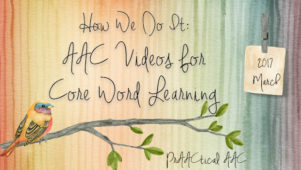
Have you ever thought of making short videos to illustrate the meaning of the core words you are teaching to your AAC learners? If so, this post is right up your alley. Teacher Angie Sheets and SLP Nicole Wingate have teamed up to bring the power of video to core vocabulary instruction and are here to share the fruits of their labor. For the past 17 years, Angie has been teaching Intense Interventions to students from kindergarten through grade 4 at Bluffton Harrison Elementary School. Her AAC experiences range from “DIY on the fly” (anything that can be made in a classroom at little to no cost and meets an immediate need) to high tech. (You can follow her on Twitter @asheetsroom14). Nicole also works for the Bluffton Harrison school system, servicing pre-k through 12th grade students. Her AAC experience includes no tech (e.g., picture boards, PECS), low tech (e.g.,... [Read More...]
August 28, 2014
by Carole Zangari -
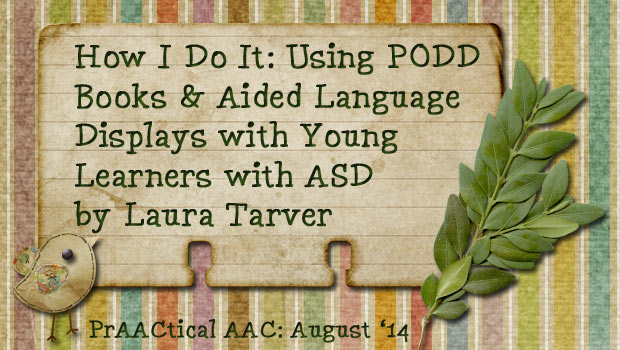
Today, we turn to the UK in a guest post by Laura Tarver. a London-based Speech and Language Therapist working with children with ASD and other complex needs. She previously worked in a primary school for children with ASD, where PODD and Aided Language Displays were introduced as part of a school wide approach in order to enhance the communication-friendly environment for all pupils. In this post, she shares how they used PODD books and aided language input to build the students’ communication skills. :::::::::::::::::::::::::::::::::::::::::::::::::::::::::::::::::: PODD (or Pragmatic Organisation Dynamic Display) communication books were developed in Australia by Gayle Porter, originally for children with cerebral palsy. As their use becomes more widespread throughout the world, practitioners are considering the benefits of using them with other clinical populations. Their structured organisation and emphasis on visual communication means that they are also a valuable tool for developing the communication of those with... [Read More...]









